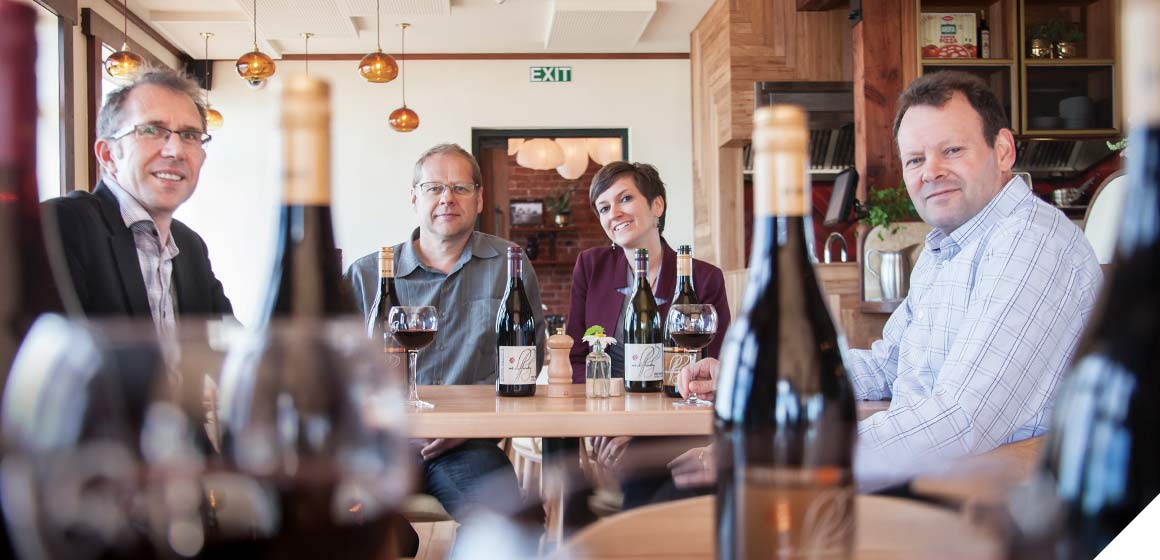
Cutting-edge techniques are being used to inform the future of Central Otago wines, helping identify what makes a truly great pinot noir.
Identifying the many components that combine to make a great pinot noir should eventually give Central Otago winemakers a greater understanding of what is needed to get the best out of their vintages.
Professor Phil Bremer, Pat Silcock and Claudia Schueuermann (Food Science), along with Dr Alan Hayman (Chemistry) have been working closely with Mt Difficulty Wines in Bannockburn, Central Otago, to tease out the multitude of factors involved in wine quality.
Schueuermann, who is tackling the research as part of her PhD, says Mt Difficulty produces ultra-premium single vineyard pinot noir among its suite of wines.
"The ultra-premium wines are produced from three different vineyards which are quite close together. Each of these wines have their own characteristics and they want to know why they are different to wines from their other sites," she says.
"We thought we might look at the whole winemaking process and see if the grape juice is already different between the sites or if the characteristics appear during the winemaking process."
Bremer, who is supervising the project, says understanding that would help Mt Difficulty move more of their wine production into the ultra-premium category.
"Can you start off with any grapes and turn them into an ultra-premium wine or do you have to have the necessary characteristics at the start and keep them or enhance them during the process?"
"They want to know if there is something they can do, either in their viticultural practice or in the winemaking process, that can move in that direction. Can you start off with any grapes and turn them into an ultra-premium wine or do you have to have the necessary characteristics at the start and keep them or enhance them during the process?" he says.
"We're analysing the juice before it is turned into wine, then during the fermentation process – both towards the end of fermentation and after fermentation – and after the wine has spent some time in barrels."
Tasting a wine effectively uses four senses, taking in colour, aroma, mouth feel and taste, which are all driven by a variety of compounds. Silcock, who is the manager of the Product Development Research Centre at the Department of Food Science, says it is important to consider what are known as the volatile and non-volatile compounds which are involved in aroma and taste respectively.
"When you put something into your mouth, the non-volatile components give rise to the taste perception on your tongue and to the mouth feel – and the aroma compounds go up the back of your throat and into your nose space. These sensory signals are then integrated in your brain to give you your perception of the wine."
They are using the best available science, examining the volatile aroma compounds through Proton-Transfer Reaction-Mass Spectrometry (PTR-MS) and Gas Chromatography-Mass Spectrometry (GC-MS), and analysing the non-volatile taste compounds – such as tannins, acids and sugars – using Proton Nuclear Magnetic Resonance Spectroscopy (1H-NMR) and Fluorescence Spectroscopy. Around 32,000 data points per sample are being measured to build a profile of each wine by looking at the patterns in those data points.
Hayman, who is lending his expertise in organic and flavour chemistry, says they can effectively create a unique wine fingerprint or signature of the volatile and non-volatile components.
"We are at the stage where we have identified differences, but now we need to understand what are the determinants of those differences. That is where the study will go," he says.
"Hopefully we can differentiate the expression of the terroir in the wine as opposed to the winemaker's hand, by following the process from go to whoa. That would be useful to the winemakers."
Schueuermann is still analysing the huge amount of data collected. "We want to identify the differences and what creates them, but we still don't know if these differences are the ones that consumers taste. That would be the next step."
Funding
- Mt Difficulty Wines